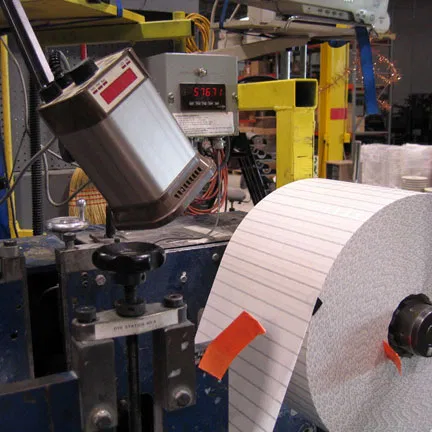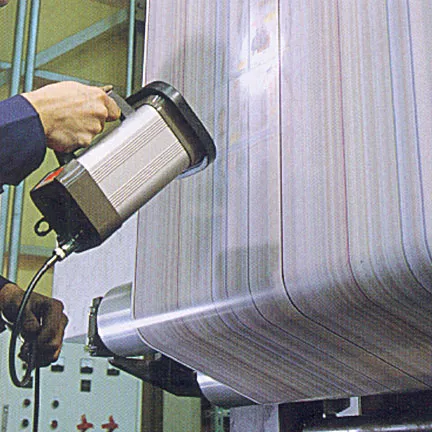Stroboscopes for speed measurement and preventive maintenance in the industrial sector. LED stroboscopes for quality control and inspection of moving objects.

- Measurement applications of print speed and quality in the printing industry, directly on the production line, without downtime or slowing down the process.
- Applications of observation of repetitive movements for the determination of any assembly errors or preventive wear of moving parts.
- Measurement visualization on easily readable display and controls designed for easy synchronization of the number of flashes per second with the process under observation.
- Battery powered models for easy and easy transport or with mains power supply for fixed applications on production lines.
Stroboscopes are tools that allow you to observe and studying an object in motion, which can be rotary or oscillatory, as if it were stationary, as well as measure its speed.
The operating principle is based on the observation, in low light conditions, of the object in constant motion, illuminated by very short flashes of high intensity light.
When you observe a perfectly still image of the object in motion, it means that the flashing frequency of the stroboscope coincides with the speed of rotation or of the oscillatory motion. speed measurement itself, without any contact with the moving mechanism
The main element consists of a special xenon or LED lamp capable of emitting up to 5000 flashes per second, or 300000 per minute. This very high frequency value allows you to observe an object that cyclically moves, vibrates or rotates on its axis even at very high frequencies.
DT-300 series Xenon stroboscopes
- Maximum precision and very stable flashing
- Simple to use controls located on the rear side of the instrument
- Easy to read LED display even in poor visibility conditions
- Detachable handle for fixing on adjustable arm
- 12 V DC output for external sensors, photocells and proximity
- Accepts external trigger signals and provides synchronization pulses at the output
- Phase adjustment for better viewing and synchronization
- Quick selection of double and half blinks for error-free and easy-to-set reading
- Flash rate control with large and practical knob for easier adjustment.
ST-1000 series portable LED stroboscopes
- Wide flash range 60 - 40000 flashes / min. it can be adjusted to suit almost any high-speed application
- Easy control of operations
- Flash speed memory button: 10 user-defined flash speeds for later recovery
- Function to increase / decrease the value of the flashing speed
- Coarse / fine tuning button
ST-320 series portable LED-UV stroboscopes
- Wide flash range 60 - 120.000 flashes / min. (1-2000 Hz) can be adjusted to suit almost all high speed applications
- Long life UV light LED operation for UV ink applications
- Adjustable flash pulse duration allows for clearer images for detailed inspection
- Phase shift advances or delays flash times for displaying gear teeth, cutting surfaces, repetitions, or "drifting" images
- The input sensor sync function allows process machines to control the flash speed
- Delay time adjustment combined with leading or trailing edge activation simplifies process setup when using external signal input
- Buttons X2 and 1/2 for a wide variation of the adjustment rate or +/- for fine adjustment
- 1 / 4-20 UNC connection for permanent mounting applications (support arm instead of handle)
TECHNICAL IN-DEPTH
Typical applications of stroboscopes
- Measurement of print speed and quality in the printing industry
- Rotation speed measurement of pulleys
- Checking the integrity of the transmission belts
- Iinspection of high speed motors and electrospindles for special machining

Speed and quality measurement in the printing industry.
The use of stroboscopes allows you to perform a automatic counting of the number of strokes / minute of machines that have repetitive cycles.
On machines equipped with synchronization photocells, or with the signal coming from the PLC of the machine, it is possible to perform a fast and immediate synchronization of the stroboscope with the production process and see the product exactly as if it were standing still directly during printing, die-cutting or during packaging.

Preventive maintenance and correct mechanical assembly check
It is not always possible to observe the behavior of mechanical parts in motion to verify their correct assembly or the presence of abnormal vibrations due to irregular wear.
The use of stroboscopes allows you to freeze the movement of gears, levers, valves or any mechanism that works with repetitive motion at a high number of times per second.

Control of printing and correct setting in the textile and paper sector
Strobes allow you to freeze the motion of a continuous object or tape that has repetitive motion or regular printing.
This makes it easy to observe if a trademark, logo or text is printed correctly, without smudging, with the correct color and font references.
Stroboscopes - Introduction to choice
There are many stroboscopes on the market with very different characteristics and prices.
In this section we collect some tips that we believe may be invaluable in selecting the correct tool.
Intensity and quality of light
Much of the cost of the stroboscope is determined by the quality of the lamp used and the amount of light it is capable of emitting.
Stroboscopes must be able to emit flashes of light with an extremely short pulse duration, in the order of a few microseconds (some drop below 10 microseconds), otherwise the strobing effect is not visible or the quality of the display of the object is poor.
Not only must the lamp emit fast and very bright pulses of light but it must also be able to last for several million cycles because the stroboscopic effect is often observed at very high frequencies.
Therefore all the goodness of the stroboscope is played on the quality of the lighting system.
Often medium-low end stroboscopes characterized by very competitive costs employ lamps whose duration is limited in time and the light emitted is of insufficient intensity to observe the object.
Furthermore, some stroboscopes do not allow to change the lamp compromising the use of the entire instrument when the lamp has exhausted its life. Always pay attention to the possibility for a stroboscope to be able to change the lamp (unless it is an LED stroboscope and therefore maintenance-free).
Another problem that must always be kept in mind is the presence of ambient light. In fact, it is not always possible to work in a completely dark environment and the light emitted by the stroboscope must always contrast the light of the surrounding environment.
Very often inexpensive stroboscopes are tested in completely dark environments and when working in the field the desired effect is not obtained.
Xenon and LED technology
Essentially there are two technologies: Xenon and LED.
Xenon technology allows to obtain flashes of light with high energy (and therefore high luminous intensity) and with very competitive costs.
But the Zenon lamp is subject to deterioration. It is therefore necessary to provide for the replacement after a few million flashes.
LED technology has the advantage of having a practically unlimited life and does not require the replacement of the lamp. It also has the advantage of being able to emit a much higher number of flashes per minute than Xenon technology.
The disadvantage of LED technology is the higher purchase cost (partially amortized by the absence of maintenance) and the lower light produced at the same price range (even if in the future with the technological evolution of LED systems there will be a reduction in the costs).
The emission optics
All the light produced by the lamp must be directed to the object to be illuminated.
The design and construction of the optical part of the stroboscope must be treated in detail.
Stroboscopes of medium-low range and characterized by very low costs often have the optical part with the passage of months loses the characteristics of brightness or light transmission with the consequence of no longer having the characteristics of initial brightness.
Portable instrument batteries
As for all devices powered by rechargeable batteries (mobile phones, cameras, personal computers) the choice of good quality batteries allows to keep the stroboscope in conditions of efficiency and duration.
On the contrary, low quality batteries tend not to guarantee a correct recharge and consequent limited working times or malfunctions in the light emission system.
A battery powered stroboscope should always have a system of high quality batteries and above all interchangeable in order to maintain the quality of the product purchased over time.
The accuracy of the Flash
Very often stroboscopes are used not only to "freeze" the movement of an object but also to measure its frequency of movement or rotation.
The accuracy in generating the pulses also determines the accuracy of the measurement. Cheap strobes also tend to have very low accuracies in determining the frequency of movement.
The accessories
Often the operator using the stroboscope does not work in the laboratory but directly on the production lines or in difficult environments.
The presence of a complete set of accessories guarantees complete freedom of use of the stroboscope (carrying cases, protective cases, belt clip, support tripods, fixing brackets, multi-voltage power supplies)
The external trigger
A useful function to be able to “hook” the driving frequency of the stroboscopic lamp to the production machine or to a specific event.
In this way the stroboscope's flashing frequency is “automatically” linked to the production machine and therefore it takes less time to link the repetitive movement to be examined with the stroboscope.
Related items

LED strobes

Vision systems



